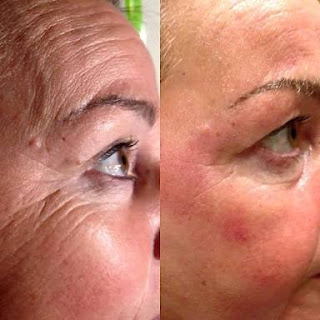INTENS PULSE LIGHT HAIR REMOVAL
How does IPL permanent hair reduction work?
The newest generation of Intense Pulsed Light (IPL) systems, produces a precise beam of light energy, which safely transmits through the skin, selectively targeting pigment in hair the follicles. When this light is absorbed by the pigment in the follicle of the hair, it coverts to heat, which in turn causes thermal damage to the follicle and permanently destroys the hair. The heat also disables the cells responsible for new hair growth.
What are the benefits of IPL?
Patient Comfort / Patient Acceptance
Waxing, electrolysis, and even shaving can be cumbersome treatments, which lead to discomfort and skin irritation. Electrolysis and waxing in particular can be quite painful and patient acceptance for repeat procedures can be limited by this experience. IPL treatments are significantly more comfortable with no skin irritation. The IPL supports active cooling in the hand-pieces, which keeps the surface of the skin comfortable throughout the procedures.
PERMANENT Hair Reduction
Based on the absorption of specific wavelengths of light energy which are transformed into heat below the surface of the skin, Intense Pulsed Light compromises the body’s ability to re-grow hair in the treated area. Permanent and long-lasting results!
In a simple phrase: 'FAST AND EASY'. Preparation for the IPL treatment is minimal, as body hair does not have to be grown out prior to the treatment. The hand-piece utilized for the treatment covers larger body areas than alternative methods. Thus minimizing the time of the treatment, and the active cooling integrated within the hand-piece provides for additional comfort.
Fast and Convenient Treatments
The large surface area covered by the specialized IPL hand-pieces enables fast and effective treatments. With no post-treatment discomfort, it’s easy to receive treatments at lunch and then return to the office that afternoon. A full set of legs could be treated in less than 1 hour, and treatments are effective without the requirement to have hair grow out before the treatment, meaning you can shave right up until your IPL session.
What are the actual treatments like?
Who is a candidate for treatment?
The sensation is often referred to as a gentle 'snap' with minimal to no sensation subsequent to the treatment. In some cases, dependent on the procedure, skin type, and the treatment area, clients experience some mild redness and tenderness in the area, which does not interfere with normal activities and usually subsides within a day.
What is the difference between Laser Hair Removal and IPL?
Fundamentally they have a similar mechanism of action (photo-thermal), however two significant benefits of IPL are: more speed and less sensation. Larger hand-pieces means IPL technology can perform procedures up to ten times faster than traditional lasers and with active cooling in the hand-pieces, the sensation of IPL is far less intense.
Hair grows in three cycles called Anagen, Catagen, and Telogen. IPL and laser technology most effectively interacts with hair in the Anagen (or active growth) phase when the hair is highest in pigment. Hence multiple treatments are required to accomplish permanent hair reduction. On average approximately 20% reduction will be noticed in the initial treatment and as much as 95% reduction can be realized in four to six treatments. Remember after the treatments the reduction will be permanent!
Men, women and children ... basically anyone can be treated with an IPL. Treatments are customized according to your skin type, hair colour and treatment area. Treatments are effective on all skin types and hair colours. Any body part including underarms, legs, back, face, neck, bikini ... etc can be treated. Special protection is required when working closely around the eyes.
How many treatments will I require?
What happens immediately after a treatment?
IPL works in a minimally invasive manner to thermally destroy the hair. This is what makes the procedure so fast and comfortable. Two or three days after the treatment, stubble may reappear. This is NOT new hair growth, but simply the body shedding the thermally damaged hair; including the bulb.
When this hair is completely shed, it's time for your next treatment (typically four to six weeks). As IPL penetrates through the skin right to the bulb of the hair, it's still OK to shave between treatments if you like, but DON’T tweeze or wax, as that will remove the target.
Are there any factors that might affect treatment?
Subsequent to treatments you may experience some redness and/or warmth at the treatment site, which is normal and can be cooled with cold wet compresses if desired. It is recommended to avoid vigorous exercise, perfumed deodorants, heavily chlorinated pools and / or hot whirlpool baths, saunas, etc. for 12 – 24 hours subsequent to treatments.
Certain factors may make your body more sensitive to light, which don’t exclude clients from treatments but must be disclosed during the consultation. Certain medications such as muscle relaxants, anti-depressants, anti-cancer drugs, acne medications and topical creams containing Retin-A, will have an effect on treatment parameters. Test patches prior to treatment ensure safe and effective results for any client situation.
Are there any side effects of treatment or special post treatment instructions?
For best results, active tanning and use of artificial tanning products should be discontinued prior to and during treatments. After treatment, use Sunblock (SPF25+) on the treatment area. You can shave during treatments, but do not wax or tweeze the hair, as this will remove the target (the bulb).
Can I remove hair between treatments?
This is an excellent question and the answer is the same as it is for electrolysis. You definitely cannot tweeze or wax. If you tweeze or wax between treatments, you physically remove the target hence reduce the Intense Pulsed Light’s ability to destroy it (you can’t destroy what isn’t there).
You can however shave between treatments as the objective is to interact with the matrix or bulb and shaft of the hair, which is untouched by shaving. Ideally large body areas should be shaved prior to coming to the clinic for an IPL treatment to cut down on the time of treatment, as surface hair must be removed prior to the treatment.
Why is my hair still growing?
Avoid sun tanning four weeks prior to / and between treatments and allow your tan to fade so that skin pigment is 'normal' prior to the first treatment.
This is a common comment for new users of intense pulsed light systems. Subsequent to administering a pulsed light treatment, the body requires time to shed the hair which had been thermally destroyed. It may take eight to ten days on some people and perhaps two to three weeks on others to fully shed the thermally damaged hair.
Even though it appears as though hair continues to grow, it is actually the body shedding the hair entirely, and over time the treated hair will grow out of the skin. This should not be mistaken for continued hair growth.
How should the treatment area look immediately after treatment?
Acceptable treatment responses include:
Darkening of pigmented lesions may occur within a few minutes and/or up to a few hours subsequent to treatments. Clinically effective treatments will cause pigmented lesions to darken prior to drying out and sloughing off which may take several days to two weeks.
Immediate disappearance of small facial Telangiectasia – small vessels commonly referred to as 'spider veins' typically found on the side of the nose or upper cheek area may disappear immediately subsequent to the treatment. This will depend largely on the size (diameter) and depth of the vessel.
What special instructions are there for prior to and after treatments?
Prior to treatment:
Remove all make-up and creams from the treatment site.
Ideally pre-shave the treatment area for hair removal.
Discontinue sun bed use and 'fake tanning' products at least four (4) weeks prior to treatment.
Do not wax or tweeze treatment site prior to hair removal treatment (shaving OK)
After Treatment(s):
Limit your sun exposure as much as possible subsequent to treatment.
Use a high SPF factor sunscreen when exposed to the sun between / and after treatments.
Can pulsed light be used to treat stretch marks?
Cool any areas which remain warm after treatment with cooling aloe vera gels, cold compresses or frozen gel packs.
Discontinue sun bed use and 'fake tanning' products.
Do not wax or tweeze treatment site between hair removal treatments.
Avoid extremely hot baths, whirlpools, saunas, or heavily chlorinated swimming pools for 12 – 24 hours subsequent to treatments.
Avoid strong deodorants subsequent to hair reduction treatment of the underarms.
Avoid vigorous exercise for 12 – 24 hours subsequent to treatments.
What are the common contra-indications associated with pulsed light treatments? ... Who should not be treated? Who should be treated with caution?
Diabetics - Type I and Type II. Diabetics in general have a compromised immune system therefore are at greater risk of delayed healing and infection in the case of an adverse effect hence are not the ideal candidates fore treatment however Type I diabetics are routinely treated with pulsed light in a safe and effective manner.
Pregnancy: Those who are pregnant are not completely contra-indicated, but must be advised they are not the ideal candidates for treatment because of the hormonal and pigmentary changes that can occur during pregnancy.
Suntanned Skin: Do not treat sun-tanned skin as the increased level of melanin in the skin can cause unpredictable results including long term pigmentation changes.
How long should I stay out of the sun prior to and after IPL treatments?
It is recommended for you to be out of the sun 3 weeks prior to treatment or for the appropriate timeframe for their skin to return to their natural colour. It is also recommended that you do not tan or use tanning products in the timeframe between a prescribed series of pulsed light treatments as overactive melanin could cause a pigmentation effect.
Yes, the selective band of wavelengths emitted from the IPL, target pigment to destroy the P-Acne bacteria, without the requirement of any topical chemical agents. The light also stimulates collagen production to help resolve the acne scarring.
Yes. Stretch marks can be treated with intense pulsed light. The protocol would be similar to that used to perform a photo-rejuvenation procedure considering the skin type of the patient. As a general rule, lower body areas (i.e. – the abdomen) typically require less energy to accomplish similar treatment objectives as higher body areas (i.e. – the face).
Can you treat the spider veins on my leg?
Yes. These treatments are very effective. As opposed to the side of the nose or upper cheek where vessels may disappear instantly or within a few days, the deeper, thicker vessels (spider veins) often found on the lower legs will take longer (up to ten weeks in some cases) to resolve and typically darken and constrict subsequent to treatment. The pulsed light systems are NOT designed to treat large leg veins and typically will NOT resolve veins effectively which are greater that 2mm in diameter at greater than 2mm depths.
Can IPL help clear up my active acne and acne scarring?
Yes, the selective band of wavelengths emitted from the IPL, target pigment to destroy the P-Acne bacteria, without the requirement of any topical chemical agents. The light also stimulates collagen production to help resolve the acne scarring.
 Surgery: Fat deposits are eliminated by means of ultrasonic waves and then aspirated in different areas improving the body contour.
Surgery: Fat deposits are eliminated by means of ultrasonic waves and then aspirated in different areas improving the body contour.



































